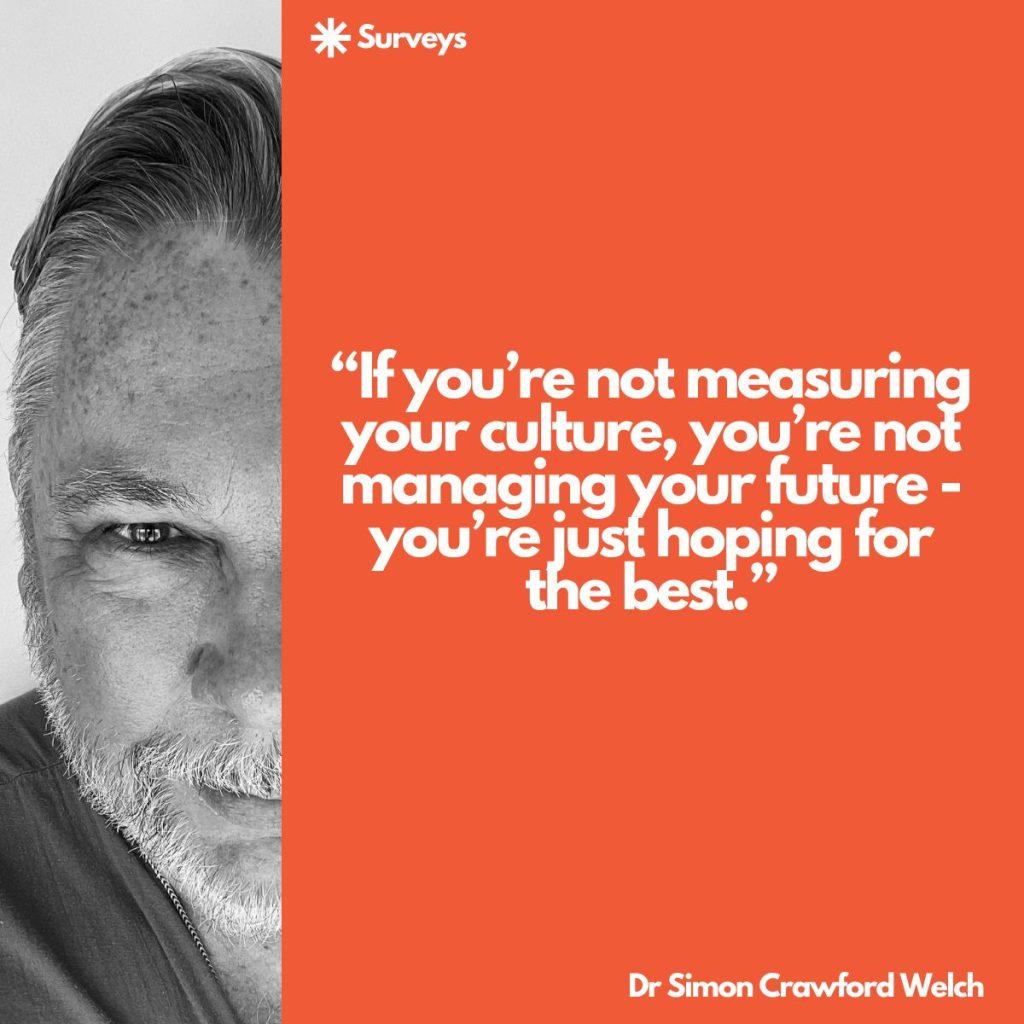By
Dr. Simon Crawford Welch

“Culture eats strategy for breakfast.” (Peter Drucker)
It’s one of the most quoted lines in leadership circles, and for good reason.
In just five words, Drucker captured something that every seasoned leader eventually learns the hard way: you can have the best strategy, the slickest decks, the sharpest hires, and the most ambitious roadmap – but if your culture is broken, none of it sticks.
Culture isn’t the soft stuff. It’s the real stuff – the unwritten rules, the day-to-day behaviors, the tone in meetings, the way people respond to pressure. And it either propels your company forward… or quietly drags it down.
But here’s the big question: How do you measure something as invisible and nuanced as culture? How do you know if what’s written on the wall is actually showing up in the hall?
Why Measure Culture at All?
It’s tempting to treat culture as a vibe – a feeling you get when you walk through the office, chat with a few employees, or glance at your Slack channels. But when culture goes unmeasured, it tends to drift. Assumptions replace data. Anecdotes outweigh insight. And by the time red flags show up in retention or performance, the damage is already done.
Measuring culture gives you a diagnostic tool – a way to align your values with reality, uncover friction points, and spot bright spots worth replicating. It allows you to move from gut feel to ground truth.
Here’s what you gain when you take it seriously:
- Visibility into the health of your organization
- Clarity on whether your stated values are being lived
- Insights into engagement, inclusion, trust, and morale
- Early warning signs of toxicity, burnout, or misalignment
- A foundation for people-centered strategy
Culture, after all, is not what you say – it’s what you tolerate, reward, and repeat. Measurement helps you find the gap between the aspiration and the reality.
What Are We Actually Measuring?
Before diving into techniques, it’s important to clarify what we mean by “culture.” It’s not just how “happy” people are. Organizational culture includes:
- Core values in action
- Leadership behavior and accessibility
- Psychological safety
- Inclusion and belonging
- Trust in management
- Openness to feedback
- Accountability and recognition
- Norms around communication, conflict, and decision-making
This is why one-size-fits-all surveys often fall short. Culture is complex. To measure it well, you need to ask the right questions—and know what kind of signal you’re listening for.
The Most Common Survey Tools to Measure Culture
Let’s walk through the most prevalent ways companies measure culture—what they capture well, and where they fall short.
- Employee Engagement Surveys
Best For: General culture check-ins, sentiment, and macro trends
Common Tools: Gallup Q12, Culture Amp, Glint, Peakon
These are the most familiar. Usually administered annually or bi-annually, engagement surveys aim to gauge how connected, motivated, and satisfied employees feel in their work and within the company. Questions often center on:
- “I know what’s expected of me at work.”
- “I feel valued by my manager.”
- “I believe leadership communicates effectively.”
Pros:
- Broad participation and benchmarking
- Clear numerical scores that can be tracked over time
- Easy to roll out across large orgs
Cons:
- Often too broad to diagnose specific cultural issues
- Long lag time between insight and action
- Risk of survey fatigue if follow-through is weak
Bottom Line: A useful temperature check – but not a complete culture diagnosis.
- Culture-Specific Pulse Surveys
Best For: Targeted feedback on culture dimensions
Common Tools: Custom Google Forms, CultureIQ, Officevibe, SurveyMonkey
Pulse surveys are shorter, more frequent, and laser-focused. Instead of trying to capture everything at once, they ask five to ten quick questions on specific themes:
- “Do you feel safe speaking up in your team?”
- “Are our values reflected in how decisions are made?”
- “Do you trust senior leadership?”
Pros:
- Timely and flexible
- Easy to segment by team, region, or function
- Builds a habit of feedback and response
Cons:
- Can become noise if insights aren’t acted on
- Risk of over-surveying without strategic intent
- Requires cultural maturity and transparency to work well
Bottom Line: Ideal for tracking specific aspects of culture in real-time – when backed by meaningful follow-up.
- Organizational Network Analysis (ONA)
Best For: Mapping informal influence and communication patterns
Common Tools: Humanyze, Microsoft Workplace Analytics, custom platforms
ONA looks at how information flows, who people go to for advice, and where silos or gatekeepers exist. It maps relationships and collaboration, often by analyzing metadata (not content) from email, chat, and meeting data.
Pros:
- Reveals hidden influencers and bottlenecks
- Shows how culture plays out through networks
- Doesn’t rely on self-reporting
Cons:
- Requires significant data and privacy oversight
- Not always actionable without context
- Can feel invasive if not handled with transparency
Bottom Line: A powerful layer of insight – best used alongside other tools, not as a standalone.
- 360° Feedback & Values Alignment Surveys
Best For: Assessing how well behaviors align with values and leadership expectations
Common Tools: Lattice, Reflektive, internal HR tools
These tools invite peers, direct reports, and managers to provide feedback on behaviors – especially tied to cultural values:
- “This leader models transparency.”
- “This person embodies our value of ‘all in.’”
- “This team encourages diverse perspectives.”
Pros:
- Ties culture to specific behaviors
- Supports leadership development and accountability
- Encourages reflection and continuous improvement
Cons:
- Can feel subjective or political if not framed well
- Requires trust in the process to work
- Time-consuming to administer and process at scale
Bottom Line: High-value insights-especially for culture change efforts – but needs strong facilitation and follow-up.
Beyond the Survey: Don’t Forget the Human Element
Surveys are essential – but they’re not the full picture.
Culture is felt in conversations, observed in meetings, and reinforced in how leaders respond to pressure. So in addition to quantitative data, consider qualitative tools:
- Listening sessions
- Skip-level interviews
- Anonymous Q&As
- Storytelling around values in action
Sometimes, the most powerful culture insights come not from a score – but from a story that reveals what really matters to your people.
So… What Do You Do With the Data?
Measuring culture is only valuable if you do something with what you learn.
Here’s the playbook for using culture data effectively:
- Acknowledge the findings. Transparency builds trust – even when the news isn’t all good.
- Highlight what’s working. Double down on strengths, not just problems.
- Choose 1–3 clear priorities. Don’t try to fix everything at once.
- Co-create the response. Involve teams in crafting solutions.
- Close the loop. Show people how their feedback led to change.
- Repeat regularly. Culture is a living system – keep listening.
Culture IS the Strategy
Peter Drucker wasn’t being clever – he was being prophetic.
Culture isn’t a side dish. It’s the plate everything else is served on. And in a world where strategy can be copied, tools can be replicated, and talent can move quickly – culture is the one advantage that’s impossible to duplicate.
So if you’re not measuring it, you’re not managing it.
Measure it well, act on it boldly, and you won’t just have a great culture. You’ll have a company that can weather any storm and scale with soul.
Simon Crawford-Welch, PhD, is the Founder, The Critical Thought Lab. Author of “American Chasms: Essays on the Divided States of America” & “The Wisdom of Pooh: Timeless Insights for Success & Happiness” (Available on Amazon) www.linkedin.com/in/simoncrawfordwelch



